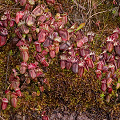Q: Cephalotus: range and conservation status
A: Cephalotus only occurs in a relatively small
area around the city of Albany, in southwestern Australia, from Augusta to Cape Riche.
As far as I know, there are no threats that are significantly damaging wild Cephalotus
populations. Fire suppression, cattle grazing, and (perhaps) invasive species are having their effects, but there are
some protected populations in D'Entrecasteaux National Park; these plants must only contend with non-natives such as rooting
damage from feral pigs. Minor as these threats may be, the fact that Cephalotus occurs in such a small area magnifies the impact
of such problems.
What might be the effects of global climate change, I wonder.
Is poaching a problem? I do not think so. On the other hand, I have noticed that Australians in the area tend to guard location information
for their favorite sites. I suspect this is a lesson learned from their having seen
sites damaged.
There is a famous coastal site that I visited, where the plants are right on the shoreline. Occasionally there are reports that the plants are
all gone, and poaching is claimed to be the reason. I don't know--but Lowrie (2013) writes about how this place periodically loses
most or all of its plants by normal weathering and storm action.
Probably one thing very important to the long term survival of this plant is the continued presence of wildland fire on the landscape.
Cephalotus is adapted to fire, and is one of the first plants to reappear after a
burn. (This may be related to the dormancy behavior that is so irksome to
cultivators.) Fire suppression would be bad for this plant, as it would allow other species to encroach and displace it.
Page citations: Gibson, R. 1999, 2001; Hummer, J. 2000;
Juniper, B.E., et al. 1989; Lowrie, A. 1998, 2013; Rice, B.A. 2006a; personal observations.



